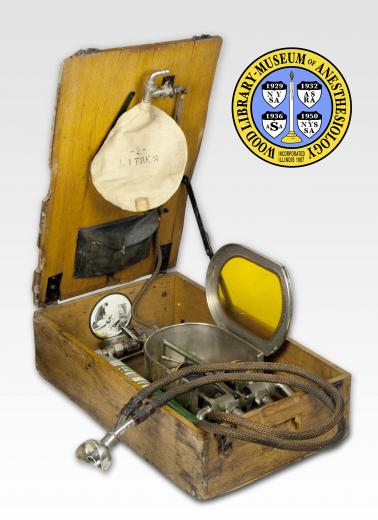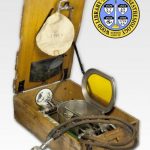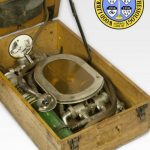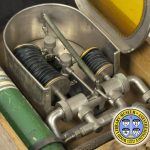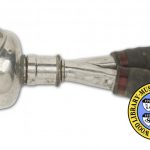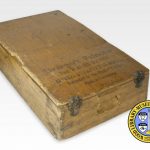Draeger Pulmotor
The Pulmotor was introduced by the Draeger company, of Lubeck, Germany, in 1907. This example was made by a Draeger branch in Pittsburgh, PA. The Pumotor was the first artificial respiration device that could automatically deliver gas and/or air at specific volumes. It was designed to resuscitate the victims of mine disasters, and also became popular for victims of smoke inhalation, drowning and electric shock. This and similar resuscitators were repeatedly denounced by Dr. Yandell Henderson (1873-1944), who specialized in respiratory physiology. He reported that they did not detect obstructions in the airway, and that the delay caused by setting up the apparatus could lead to brain damage or death. Despite these drawbacks, Pulmotors were used extensively in Europe and the U. S. as late as the 1940s.
Catalog Record: Draeger Pulmotor
Access Key: aipy
Accession No.: 2002-05-06-1
Title: Draeger’s Pulmotor / [Johann Heinrich Draeger and Bernhard Draeger].
Author: Draeger, Johann Heinrich.
Author: Draeger, Bernhard.
Corporate Author: Draeger Oxygen Apparatus Co.
Title variation: Alt Title
Title: Dräger Pulmotor.
Title variation: Alt Title
Title: Draeger Pulmotor.
Publisher: Pittsburgh, Pa. : Draeger Oxygen Apparatus Co., [1908-1925].
Physical Description: 1 resuscitation apparatus : metals, wood, rubber, celluloid ; 66 x 40 x 18.5 cm.
Subject: Resuscitation.
Subject: Respiration, Artificial.
Subject: Ventilation, Mechanical.
Subject: Ventilators, Mechanical.
Note Type: General
Notes: Title from manufacturer’s markings on wood case.
Note Type: Citation
Notes: Annual Report of the Surgeon General of the Public Health and Marine-Hospital
Service of the United States: For the Fiscal Year 1911. Washington D.C.:
Government Printing Office, 1912:69-71.
Note Type: Citation
Notes: Bahns E. It Began with the Pulmotor: One Hundred Years of Artificial
Ventilation. Lubeck, Germany: Dräger, 2007:10-16.
Note Type: Citation
Notes: Bause G. Draeger Pulmotor. Anesthesiology. 2009;110(6):1243.
Note Type: Citation
Notes: Gwathmey JT. Anesthesia. 2nd ed. New York: Macmillan Co., 1924:396-399.
Note Type: Citation
Notes: “Pulmotor” saves seven lives in Chicago. Popular Mechanics. March
1912:335-336.
Note Type: Physical Description
Notes: The Pulmotor is held within a wood case, approx. 66 x 40 x 18.5 cm; The wood
is water damaged and chipped; Manufacturer’s markings are on the top of the
case: “Draeger’s Pulmotor [new line] THE DRAEGER OXYGEN [new line] APPARATUS
Co. PITTSBURGH, PA [new line] Patented in the United States [new line] Made
in Germany”; Two latches at the front of the case hold the lid closed, or
unlock to open the lid; The lid can be held open by a folding hinge on the
right side of the case; Attached to the inside of the lid is a 2 liter
reservoir bag and some of the tubing for providing oxygen directly from the
oxygen tank; Also attached to the inner lid is a leather envelope-like pouch
to hold accompanying items such as tongue forceps and a buckle to hold the
mask to the patient’s face (this pulmotor is missing both); A second
reservoir bag is held in the pouch; A gas tank lays on the left side of the
case; Metal tubing from the tank directs gas to a pressure-gauge and
pressure-reducing-valve above the case for the bellows; A toggle-like lever
is marked “PULMOTOR” when pushed to the left, and “INHALATION” when pushed to
the right; A small metal tube runs from the pressure-reducing-valve to the
controlling-valve below the case for the bellows; Metal tubes connect the
control-valve to the encased bellows; The case that protects the bellows is
approx. 29.5 cm long and 22 cm wide; The case is metal with a transparent top
of orange colored celluloid framed in metal; Manufacture’s markings on the
case: “THE DRAEGER OXYGEN APPARATUS Co. [new line] PITTSBURGH PA, 422 FIRST
AVENUE; One woven-textile covered tube connects metal tubing from the
inlet-side of the controlling-valve to the oronasal-mask; Another textile
covered tube connects metal tubing from the outlet-side of the
controlling-valve to the mask; The tubes are approx. 132 cm in length; The
mask has a Y shaped connector, approx. 9 cm long; The oronasal-mask has been
bent out of its original shape and measures approx. 8 x 7 x 4 cm; Protruding
from the center of the inside of the mask is an approx. 3 cm cylindrical tube
(mouthpiece?); Also in the case is an adapter for using a tank external to
the case; The adapter measures approx. 39 x 12 x 4.5 cm and has a yolk on one
end and a threaded opening on the other; Also in the case is 73 cm of tubing
in articulated metal with rubber connections on each end, and a second
oronasal-mask, approx. 10 x 6.5 x 4.5; A 6 cm curved metal port for attaching
oxygen tubing protrudes from the outside of the second mask; The second mask
also has a nonrebreathing valve; A printed image of the pulmotor in use is on
a round piece of paper pasted to the inside of the case.
Note Type: Reproduction
Notes: Photographed by Mr. William Lyle, July 28, 2010.
Note Type: Historical
Notes: The Pulmotor was the first artificial respiratory device that could
automatically deliver an ‘appropriate’ volume of gas (smaller amounts for
smaller lung capacities, and larger amounts for larger lung capacities) and
automatically alternate between inhalation and exhalation based on
ventilatory pressure (Bahns, 2007). The pulmotor was designed in Germany for
the resuscitation of miners but soon was used by firemen and other rescue
providers throughout Europe and North America. The miners who were specially
trained to use the Pulmotor and respond to emergencies were commonly referred
to as “Draegermen” (Bause, 2009). In 1910 the US division of Scientific
Research and Sanitation, within the Bureau of Public Health, studied the
effectiveness of the Pulmotor for the resuscitation of apparently drowned
persons and determined that in certain circumstances it was more effective
than the methods of artificial respiration used at the time (Annual Report of
the Surgeon General …, 1912). The general population became familiar with
the Pulmotor through local papers and popular publications such as Popular
Mechanics, which published, in 1912, an easily understood description of how
the Pulmotor works. Use of the Pulmotor was also covered in medical textbooks
including James Gwathmey’s 2nd edition of Anesthesia. If the pulmotor did
not function automatically, an operator could power the Pulmotor by hand
(Gwathmey, 1924).
